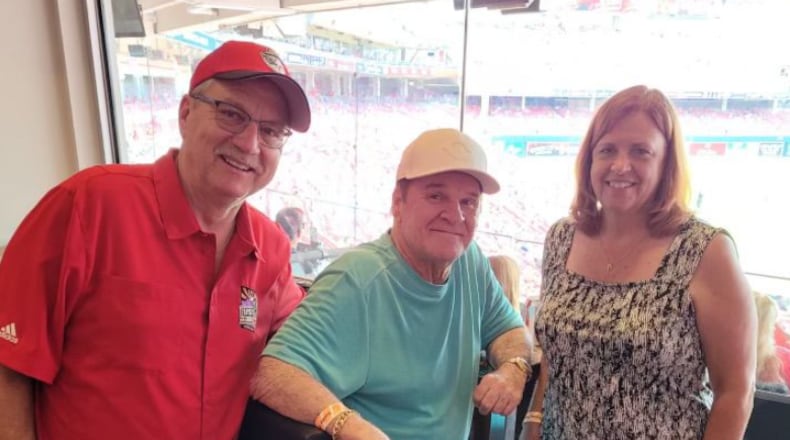Two years later, shortstop Dave Concepcion joined the party and three years later, the Reds traded for second baseman Joe Morgan and centerfielder Cesar Geronimo from the Houston Astros and the Big Red Machine was nearly complete.
While all those parts were being assembled by General Manager Bob Howsam, young boys across Reds Country were in their backyards, impersonating their favorite player with a Wiffle ball bat trying to hit a nasty curve ball.
Our neighborhood kids picked up the plastic bat and stepped toward the trash can lid that served as home plate.
Flap your left arm? Joe Leonard Morgan.
Hold your bat high? Johnny Lee Bench.
Raise your right elbow? Tony Atanasio Perez.
Crouch down? Peter Edward Rose.
All the kids wanted to be Rose. We all tried to switch-hit, stretch a single into a double during those backyard games played every morning until it was time for dinner, and when Little League season finally started after a long winter, we all wanted to wear No. 14.
For me, I never outgrew my love of the game or for Rose, even though Major League Baseball and Rose changed for the worse since I was a young boy.
The last time I saw Rose was Sept. 21 during an autograph signing at Sports Gallery in Forest Park, a sports memorabilia store owned by my good friend Mark Fugate, a Middletown native. Rose looked frail and weak. He showed his age. The 83-year-old struggled walking from his car, up one step and into the back room of the store.
He didn’t resemble the barrel-chested player who collected a record 4,256 hits during his 24-year career that included three World Series championships, 17 All-Star appearances, National League MVP honors in 1973 and a World Series MVP two years later.
When it was time for Rose, inducted into the Reds Hall of Fame in 2016, to meet the public, those who paid extra for a photo opportunity with the Hit King, he was asked if he needed help walking from the back room. He refused. A proud man, this Pete Rose.
When Rose saw the long line of fans that stretched throughout the store and how many were wearing his Reds jersey, he managed a smile through the pain. For the next three hours, Rose tirelessly signed hundreds of autographs and listened as countless fans said he was their favorite player, though some of them were too young to see him play.
Rose was at his best when a young fan nervously approached the table with a baseball in his shaking hand. That’s when Rose turned into a grandfather. He asked each boy if they played baseball and when they said yes, Rose asked about their season.
One kid, still wearing his dirty uniform, said in his last game he got two hits, just an average night at the ballpark for Rose. Then Rose asked the boy if his team won. When told the team lost, Rose said hits don’t matter in a loss.
Of all the records he holds, Rose has said he’s proudest of being the MLB player with the most wins: 1,972 games.
Later, after the crowd had left, Rose was still there sitting in his chair, his cellphone and glasses lying on the table. That’s when Fugate’s grandson, Jett, fresh from his afternoon nap, showed up. He and Rose passed baseball and shared a bag of chips.
“He had a big heart,” Fugate said of Rose, whom he called a close friend. “He loved talking to kids about baseball.”
I left Sports Gallery that day wondering when I would see Rose again. Maybe next summer if the Reds celebrated the 50th anniversary of the 1975 World Series championship season or next fall if the team honored Rose on the 40th anniversary of his record-breaking 4,192 hit.
Then on Sept. 30, just nine days later, I started getting texts from friends: “Rose has died.” “Did you hear that Pete died?”
I wiped away the tears, and searched the Internet on my phone. It was true. The Hit King was found dead in his Las Vegas residence, one day after returning from an autograph show in Nashville where he spent time with other members of the Big Red Machine, including Ken Griffey Sr., George Foster, Concepcion and Perez.
Credit: AP
Credit: AP
As I tried to comprehend how or why Rose died, I was flooded with memories, those from my childhood and as an adult.
I’m thankful that I was there to watch Rose collect hit No. 3,000 on May 5, 1978, hit No. 4,191 on Sept, 8, 1985 at a wet and dark Wrigley Field and hit No. 4,192 off San Diego’s Eric Show on Sept. 11, 1985 at Riverfront Stadium.
As a sports reporter at the Dayton Daily News, I had the opportunity to write about Rose’s return to the Reds as a player/manager on Aug. 17, 1984, then write a magazine piece on Carol Rose, his second wife and former Philadelphia Eagles cheerleader.
Then, like other Rose fans, I had to endure the last 35 years since he was banned from baseball for betting on the Reds. I didn’t believe the allegations at first. Then, as the evidence mounted, it was impossible to ignore.
Eventually Rose admitted to betting on the game he loved. He paid the ultimate price. Once a lock to be inducted into the Baseball Hall of Fame in Cooperstown, the doors to the hall remained closed to Rose.
He was known as Charlie Hustle for the way he played the game, but he also was a hustler for some of his actions away from the field.
While others will remember Rose as a damaged, gambling-addicted and corrupted character, I will remember what he accomplished on the baseball field and how he graciously treated his fans.
Thanks for the memories, Pete.
About the Author



